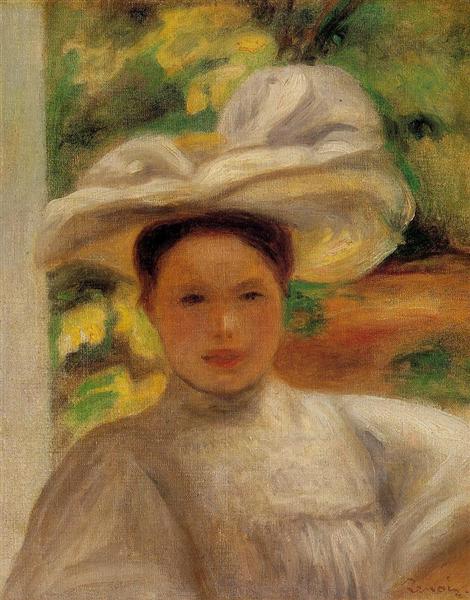Description
The work "Young Woman with a Hat," created in 1895 by Pierre-Auguste Renoir, stands as a vibrant testament to the Impressionist style, characterized by its focus on light, color, and a fresh depiction of everyday life. In this painting, Renoir captures a young woman in a splendid hat, who embodies the spirit of the Belle Époque, a time of cultural and artistic splendor in France. The central figure, whose identity has been debated, is a reflector of a fleeting, romantic moment in history, and perhaps represents one of the many muses who inspired the master.
The composition of the work is characterised by a harmonious construction in which the figure of the woman is positioned in the middle ground. The wide hat, decorated with feathers and flowers, is not only an aesthetic element, but also conveys a sense of elegance and sophistication, worthy of the fashion of the time. Renoir achieves a balance between the figure of the woman and the background, which is presented in a diffused light, contributing to the sensation of movement and light that is characteristic of Impressionism.
The use of color in “Young Woman with a Hat” is masterful. Renoir employs a rich palette of warm tones including soft pinks, golden nuances, and vibrant greens, giving the work an almost ethereal luminosity. Light filters through the scene, caressing the young woman’s skin and creating reflections that suggest texture and depth. This treatment of light not only brings the figure to life, but also evokes subtle emotions, immersing the viewer in an almost sensorial experience.
The woman’s face is at once familiar and elusive. Renoir captures her expression with loose strokes, focusing on the play of light and shadow rather than precise anatomy. This technique allows the figure to have an air of intimacy and freshness, as if the viewer could get to know her in a fleeting moment. This focus on emotional expression is emblematic of Renoir’s work, which often seeks human connection and beauty in the everyday.
The work is also representative of the change in Renoir's artistic vision during this period. As he moves into the last decade of the 19th century, his style becomes looser and freer, marked by a delight in capturing light and pure color. Renoir, as part of the Impressionist movement, moves away from the exact, formal representation of academic painting, seeking instead a more subjective reflection of reality.
Although little is known about the specific sitter behind the young woman in this portrait, there is an overall sense of freedom, youth, and vibrant city life that permeates this work. Renoir, who was always very interested in the female figure as the focus of his art, does not simply capture an image, but invokes the essence of an era, a time of joy and carefreeness. Thus, “Young Woman with a Hat” stands not only as an individual portrait, but as an echo of a period when art began to embrace life with renewed fervor.
In short, Pierre-Auguste Renoir's "Young Woman with a Hat" is much more than just a portrait; it is a celebration of color, light, and the feminine spirit of the fin de siècle. Renoir's ability to capture the ephemeral beauty of youth, combined with his meticulous attention to light and color, serves as an enduring reminder of the power of art to connect human experiences across generations.
KUADROS ©, a famous painting on your wall.
Hand-made oil painting reproductions, with the quality of professional artists and the distinctive seal of KUADROS ©.
Painting reproduction service with satisfaction guarantee. If you are not completely satisfied with the replica of your painting, we will refund 100% of your money.

